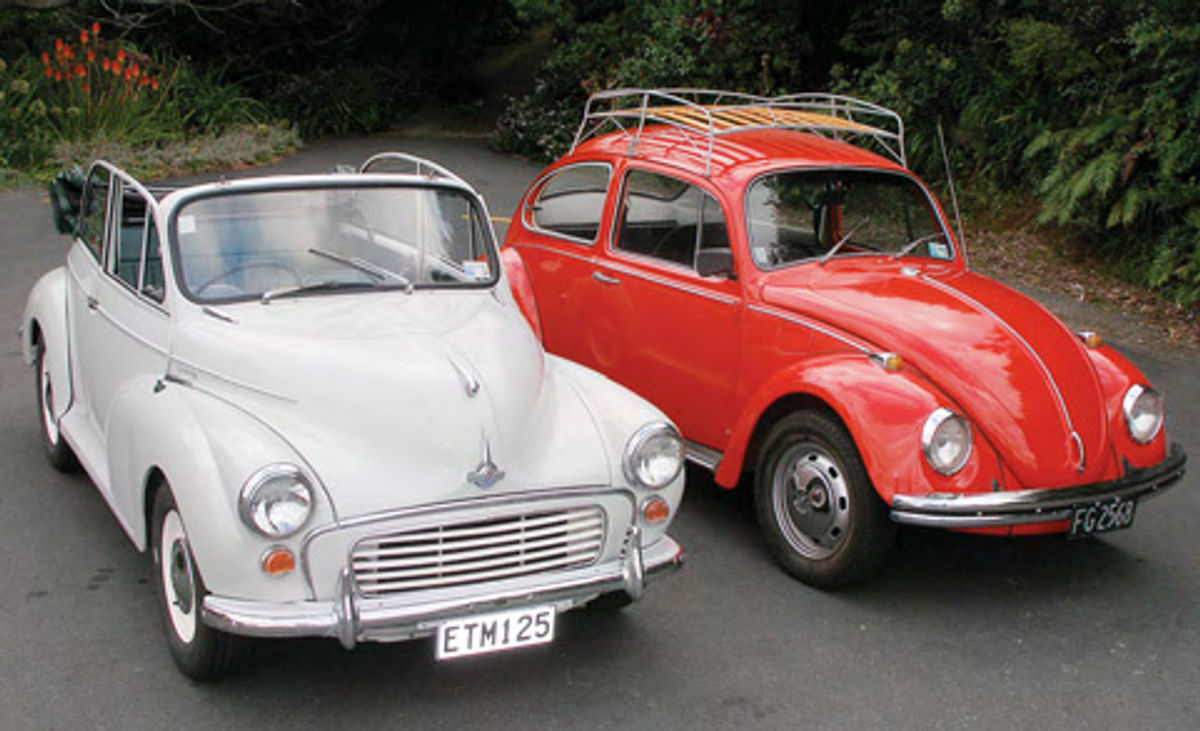Special Report VW Beetle Vs. Morris Minor
He’s Owned Both Small Imports for More Than a Decade. Which Is Better? Well, That Depends…
I BOUGHT A Morris Minor and a VW Beetle 13 years ago when I started going to New Zealand for the winter months. I acquired the 1966 Morris convertible first. That turned out to be a big mistake; one that pushed me into the purchase of the 1970 Volkswagen Beetle.
It happened like this: I bought the Morris after looking it over quickly and test-driving it. The body seemed sound, the engine ran well, and it was cheap. I should have known better.
Turns out the Morris had extensive rust in its subframe. I discovered that when I took it in for the mandatory annual Warrant of Fitness inspection. The shop slid a jack under the front cross-member, and as it went up, the jack crunched right through the crossmember. The thing had been deceitfully crafted largely out of plastic filler and then sanded and painted.
A local panel beater told me to leave it so he could evaluate the car, assuming it was even repairable.
Restoring Them With Some Modifications
Eight years later I was still putting the Morris back together, but at the time the panel beater was inspecting it, he also offered to sell me a 1970 VW Beetle. He had just fixed it up for his wife, who promptly thereafter gave birth to twins.
I bought the VW and drove it for years until its engine got tired, at which point I restored the car again and brought in a new 1600 dual port transporter engine from the States and installed it.
This woke the little car up a bit—in fact, almost too much. Instead of topping out at 72 mph, it now will do in excess of 90 if you are crazy enough to try it. The reason I say crazy is because the front end becomes airborne at about 89 mph, and the steering becomes useless. Don’t ask me how I discovered that, and don’t mention it to New Zealand’s finest.
Because I bought badly, the Morris, as noted, took me several years to restore, a little at a time on my vacations, and it too has had a couple of tweaks along the way. It sports an MG Midget head that has been ported and milled with bigger valves installed, and a custom intake manifold with twinSUcarburetors.It also has a high-efficiency extractor header exhaust. These make the Lilliputian British drophead a quite bit peppier.
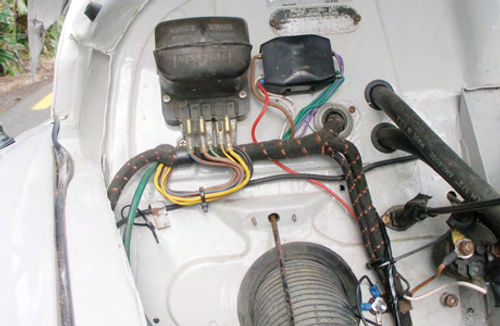
History of the Cheap & Basic
So, which is my favorite of the two cars to drive, and why? I’ll tell you about that later, but first a little history for those unfamiliar with how these two cars came to be.
There is an old blues song by The Howlin Wolf in which he says some cars are built for comfort and others are built for speed.
Well, these two cars weren’t built for either. They are neither fast, nor particularly comfortable.
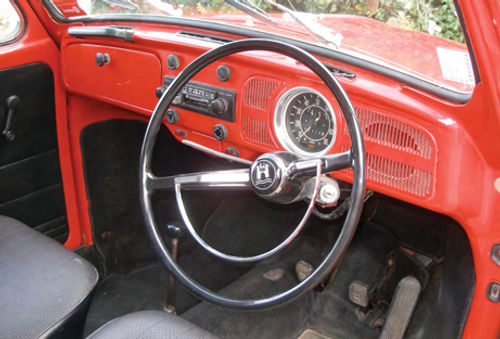
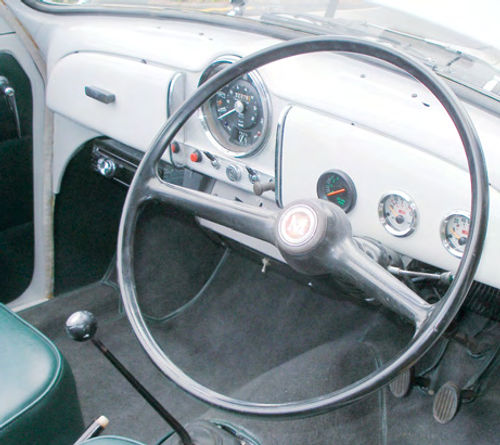
They were built instead to be cheap, reliable, basic transportation, with particular emphasis on the cheap. And they succeeded in those areas brilliantly.
The two cars look similar, though the Volkswagen design is 10 years older, having debuted in 1938 as a prototype, while the Morris Minor didn’t come out until after the war in 1948.
And though the Beetle looks every inch a car from the 1930s with its flat, one-piece windshield, rubber running boards, and bolt-on fenders, its mechanicals were quite advanced and esoteric for the time, thanks to the design team headed by Ferdinand Porsche, and heavy financial backing from the government in Berlin.
As for why the Beetle was built, the name “Volkswagen” says it all. It means People’s Car, and it was promoted as a way to put Germany on wheels the way Henry Ford’s Model T did in the United States many years earlier. However, the 1939 invasion of Poland got in the way of that happening, and the Beetle didn’t go into full production until after the war.
I’m not sure what the name Morris Minor tells us other than that the Morris Motor Company in Oxfordshire, England, built the car. There was an earlier model also called the Minor around 1930, but I have never found an explanation as to why either was dubbed the Minor.
An engineer named Alec Issigonis designed the Morris. Before World War II, he built a very advanced lightweight racecar and campaigned it himself successfully. Then he went to work for Morris in 1941 and began playing around with ideas for what would become the Minor; but as with Volkswagen, war needs took precedence. One of his projects during that period was to develop a motorized amphibious wheelbarrow for the Royal Navy. Perhaps that was the inspiration for the postwar Minor. However, though wheelbarrow-like in some ways, the Minor is not amphibious, unlike the Beetle.
Issigonis’ most famous design in the field of teensy transportation was the later Morris Mini in 1959. It is an even tinier more uncomfortable machine, but arguably the best micro-car ever. And with tuning by John Cooper, probably the fastest of them too. By putting the engine in sideways and going with front-wheel drive, Issigonis was able to create a positively minuscule machine that could accommodate four people, albeit much the same way a tin the size of a deck of playing cards will accommodate sardines.
Even the Morris Minor—which is much larger than the Mini—is pretty cramped for someone of my displacement (6’2”, 220 lbs.). Also, the seats are not adjustable, so I had to move the driver’s seat a couple of inches back and drill new mounting holes so I could get in the thing without barking my knees.
The Beetle, however, has sturdy large seats that are adjustable, and it has more head and legroom as well. I am quite comfortable in the driver’s seat of the VW just as it came from the factory, though I wouldn’t want to attempt to be a backseat passenger in either car.
Neither Was Meant for the Mainstream
It is interesting that the Morris Minor and the Volkswagen Beetle look similar, and were built for similar reasons, but in America they appealed to vastly different buyers. The VW appealed to the young anti-establishment, anti-materialistic college students of the ’60s. The car’s strange anachronistic appearance also seemed a rebellion against the over-the-top size and styling of the likes of the 1959 Cadillac and the 1967 Oldsmobile Toronado.
But what really put the Beetle over the moon in sales was that it got 24 realworld miles to the gallon (my figures— not the manufacturer’s) when most cars were struggling for 15, and it squeezed 40,000 miles out of a set of tires when most cars struggled for 20,000, and best of all, you could purchase one brand new for around $1500 back in 1966.
Also, Volkswagen’s build quality and dependability were superb. Of course, it was critical that you carried an extra fan belt because if the cooling fan failed, there went your air-cooled engine. It was also critical that you kept the engine timed properly and the valves adjusted, but other than those things, the Beetle just went on and on.
The Morris had an entirely different mystique in the U.S. It said, “I’m a bit odd.” The glee club teacher at my high school drove one, and artists and designers especially liked them. But you had to be secure enough in your masculinity that you could take a little ribbing from the guys, or you had to be a bit different and proud of it, to show up in a Morris Minor in those days. That’s partly because they were faintly comical-looking on the road and had absolutely no macho mystique; especially when sandwiched between a couple of woolly mammoths such as a fifties-era Buick Roadmaster and a full size Dodge Wayfarer station wagon, for example.
You also had to be completely fearless to compete on the freeway in a Morris because it was even smaller, lighter and less powerful than the Beetle. On the plus side, though, it did get an astounding 32 miles to the gallon, and its skinny little tires lasted nearly forever. But with a tiny 1098cc motor buzzing away under the hood, you definitely needed to be patient.
Remarkably, as with my VW and its whopping 1500cc original engine, the Morris topped out at 72 miles an hour in stock form. But with a little judicious tuning—such as I have done—you can accelerate surprisingly well, and push it to 85 without drama. And with higher gearing from a five-speed it would do even better. But it doesn’t matter to me, because the speed limit in New Zealand is 100 kilometers per hour—a touch over 60 mph—and it is strictly enforced.
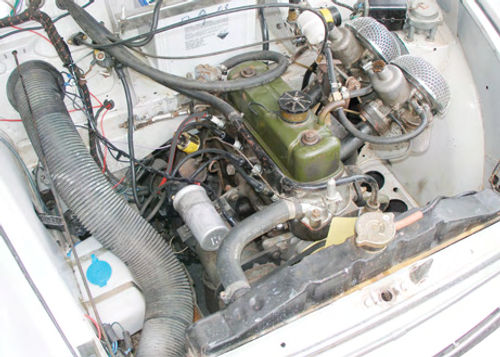
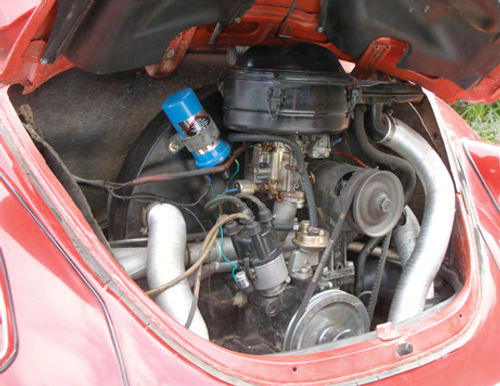
Handling and Safety Pros & Cons
Both cars handle very well, especially considering when they first came out. American cars of the ’30s and ’40s were softly sprung, heavy, and they sat up on top of their frames, so they tended to wallow and lean when cornering.
But the VW, with its unit body, torsion bar independent front suspension and swing axle rear suspension, corners very well…up to a point.
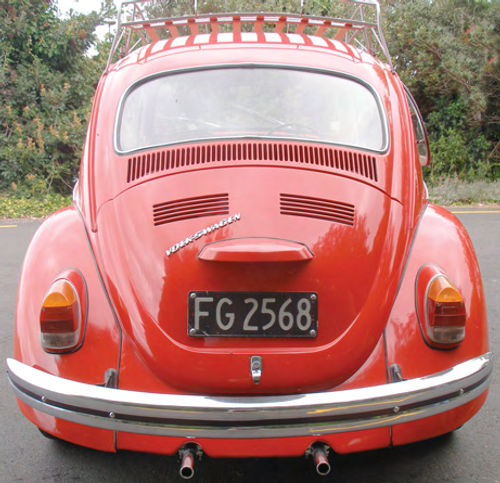

After that you are just along for the ride. That’s because if this rear-engined car comes loose in a turn, the front end comes unstuck, and that is where your steering is. Tromping on the gas to power out of the skid as you would do in a front-engined car just spins you around faster. And if you stomp on your brakes in a panic, this causes the car to dive forward, tucking the rear wheels under at the bottom. You can guess what happens next.
Luckily,Beetles are incredibly tough.I know, as I was in a near head-on up against a much bigger Subaru Legacy in the Beetle you see on these pages, and the Subaru was totaled. But after pulling the fenders off of the tires, I was able to limp home in the Beetle.
How is that possible? The answer is, the whole front end on the Beetle acted as a crumple zone. It’s nothing but sheet metal. And, luckily for me, the pan and front suspension went under the Subaru and wasn’t hurt.
All we had to do was replace the hood, fenders, apron, gas tank and front bumper and I was back in business.
I did sustain a nasty gash in the forehead, but even that turned out not to matter much because the scar runs parallel to my worry lines; so after the doc took the stitches out it just looks like a newone.
The Morris has a lighter, less durable body, so I doubt I would have faired as well in a crash in it. It is also front engined and liquid cooled, so that too could pose a problem in a head-on.
But the Morris’ handling is much more forgiving and predictable than the Beetle’s because of its conventional layout. You can power your way out of a skid, and it corners as if it were on rails despite its solid back axle and old-style lever shock absorbers.
OK, Which One Is Better…
So, which do I prefer to drive? I can answer that with an unequivocal “it depends.” If I were going on a long trip I would take the VW. It is bigger, heavier, roomier and more comfortable, though such attributes are relative, I know. It is definitely not quieter, though. The air-cooled engine mandates that the valve tappet adjustments be generous to allow for heat expansion as the engine warms up. Consequently, there is no way to make a Dubby quiet.
The Morris, though a bit buzzy, is quieter and smoother. And even though it is snug inside, it is more fun to drive for short spins. Of course, my Morrie convertible is much more exciting with the top down than with it up. With the top up, like most convertibles, the car seems a little dark and claustrophobic. The closed sedans the company made would be a bit snug too, but visibility is good in them.
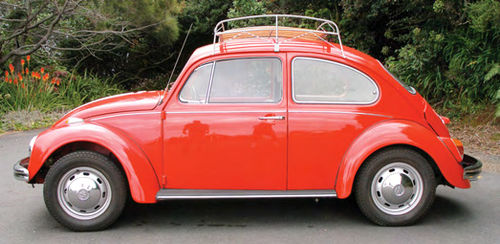


The Morris Minor was also available as a four-door sedan and as a woody wagon, neither of which were available in the Volkswagen, and both of which would have been more comfortable for more than two passengers. There was also a tiny pickup and a delivery van, which were as cute as Dinky toys, but didn’t hold much more than a couple of sacks of groceries. They look like something Peter Sellers would have driven in a Pink Panther movie.
As for dependability, both have been quite good. The Morris is generally easier to work on, with its inline liquid-cooled engine and conventional layout, though its Lucas electrical system is rather odd.
On the other hand, the VW is harder to tune, and you have to get under it to tighten the heads and adjust the valves, and that is a bit of a pain.
An Unexpected Benefit
All in all, though, both cars did what they were designed to do, and did it exceedingly well. As a result, both cars were built for many many years and were phenomenally successful—though the VW blew the doors off of the Morris in terms of production and sales, and became by far the most successful car in the world.
It must be said, though, that in Commonwealth countries such as New Zealand, the Morris actually outsold the VW. Also, an upgraded version of the Minor called the Oxford is still in production in India, sold under the brand name Hindustani. It is used mostly as a taxi and is legendary for its longevity.
And, best of all as far as I’m concerned and much to my surprise, women find both cars irresistible; especially the Morris. Women of all ages walk up to me when I park it and say things like: “Oh, it’s adorable! Will you take me for a ride in it?”
All I can say is, why didn’t I know that back in high school? In those days, I wanted a Corvette because I figured it would transform me magically from a skinny adolescent into Paul Newman. Now I realize that the glee club teacher was on to something.

